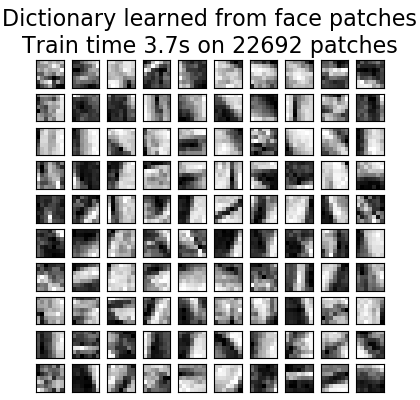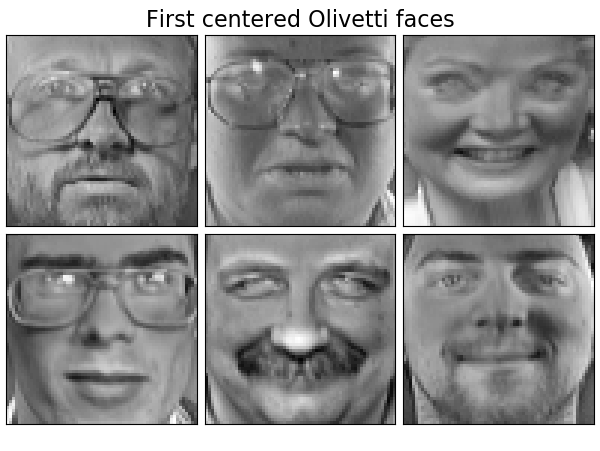sklearn.decomposition.MiniBatchDictionaryLearning¶
class sklearn.decomposition.MiniBatchDictionaryLearning(n_components=None, *, alpha=1, n_iter=1000, fit_algorithm='lars', n_jobs=None, batch_size=3, shuffle=True, dict_init=None, transform_algorithm='omp', transform_n_nonzero_coefs=None, transform_alpha=None, verbose=False, split_sign=False, random_state=None, positive_code=False, positive_dict=False, transform_max_iter=1000)
Mini-batch字典学习
找到能用稀疏代码表示数据的字典(一组原子)。
解决优化问题:
(U^*,V^*) = argmin 0.5 || Y - U V ||_2^2 + alpha * || U ||_1
(U,V)
with || V_k ||_2 = 1 for all 0 <= k < n_components
在用户指南中阅读更多内容
| 参数 | 说明 |
|---|---|
| n_components | int 要提取的字典元素的数量 |
| alpha | float 稀疏控制参数 |
| n_iter | int 要执行的迭代总数 |
| fit_algorithm | {‘lars’, ‘cd’} cd:使用坐标下降法计算lasso解(linear_model.lars_path)。如果估计的组件是稀疏的,Lars会更快。 |
| n_jobs | int or None, optional (default=None) 要运行的并行作业数量。没有一个是1,除非在joblib。parallel_backend上下文。-1表示使用所有处理器。更多细节请参见术语表。 |
| batch_size |
int 每批样品的数量 |
| shuffle | bool 是否在成批前对样品进行洗牌 |
| dict_init | array of shape (n_components, n_features) 用于热重启场景的字典的初始值 |
| transform_algorithm | {‘lasso_lars’, ‘lasso_cd’, ‘lars’, ‘omp’, ‘threshold’} 用于转换数据的算法。lars:使用最小角度回归法(linear_model.lars_path) lasso_lars:使用lars计算Lasso解lasso_cd:使用坐标下降法计算Lasso解(linear_model.Lasso)如果估计的组件是稀疏的,lasso_lars会更快。omp:使用正交匹配追踪估计稀疏解阈值:将投影字典中所有小于alpha的系数都压缩为零* X ' |
| transform_n_nonzero_coefs | int, 0.1 * n_features by default在解的每一列中目标的非零系数的数目。这只被algorithm='lars'和algorithm='omp'使用,在 omp情况下被alpha覆盖。 |
| transform_alpha | float, 1. by default 如果 algorithm'lasso_lars'或algorithm='lasso_cd',则alpha是对L1范数的惩罚。如果algorithm='threshold',alpha是阈值的绝对值,低于这个阈值,系数将被压缩为零。若algorithm='omp',则alpha为容差参数:目标重构误差的值。在本例中,它覆盖n_nonzero_coefs。 |
| verbose | bool, optional (default: False) 控制程序的冗长。 |
| split_sign | bool, False by default 是否将稀疏特征向量分割为其负部分和正部分的连接。这可以提高下游分类器的性能。 |
| random_state | int, RandomState instance or None, optional (default=None) 用于在没有指定dict_init时初始化字典,在shuffle被设置为True时随机变换数据,以及更新字典。在多个函数调用中传递可重复的结果。看到术语表。 新版本0.20。 |
| positive_code | bool 在寻找代码时是否加强积极性。 |
| positive_dict | bool 查找字典时是否要加强积极性。 新版本0.20。 |
| transform_max_iter | int, optional (default=1000) 如果algorithm='lasso_cd'或lasso_lars,则执行的最大迭代次数。 新版本0.22。 |
| 属性 | 说明 |
|---|---|
| components_ | array, [n_components, n_features] 从数据中提取的样本 |
| inner_stats_ | tuple of (A, B) ndarrays 由算法保存的内部充分的统计信息。保留它们在在线设置中很有用,以避免丢失演进的历史,但它们对最终用户不应该有任何用处。A (n_components, n_components)是字典协方差矩阵。B (n_features, n_components)是数据近似矩阵 |
| n_iter_ | int 运行的迭代次数。 |
| iter_offset_ | int 以前执行的数据批的迭代次数。 |
| random_state_ | RandomState 由种子、随机数生成器或np.random生成的RandomState实例。 |
另见:
笔记
参考文献
J. Mairal, F. Bach, J. Ponce, G. Sapiro, 2009: Online dictionary learning for sparse coding (https://www.di.ens.fr/sierra/pdfs/icml09.pdf)
方法
| 方法 | 说明 |
|---|---|
fit(self, X[, y]) |
根据X中的数据拟合模型。 |
fit_transform(self, X[, y]) |
拟合数据,然后转换它。 |
get_params(self[, deep]) |
获取这个估计器的参数。 |
partial_fit(self, X[, y, iter_offset]) |
使用X中的数据作为一个小批更新模型。 |
set_params(self, **params) |
设置这个估计器的参数。 |
transform(self, X) |
将数据编码为字典原子的稀疏组合。 |
__init__(n_components=None, *, alpha=1, n_iter=1000, fit_algorithm='lars', n_jobs=None, batch_size=3, shuffle=True, dict_init=None, transform_algorithm='omp', transform_n_nonzero_coefs=None, transform_alpha=None, verbose=False, split_sign=False, random_state=None, positive_code=False, positive_dict=False, transform_max_iter=1000)
该方法适用于简单估计器和嵌套对象(如管道)。后者具有形式为
fit(self, X, y=None)
根据X中的数据拟合模型。
| 参数 | 说明 |
|---|---|
| X | array-like, shape (n_samples, n_features) 训练向量,其中样本数量中的n_samples和n_features为feature的数量。 |
| y | Ignored |
| 返回值 | 说明 |
|---|---|
| self | object 返回实例本身。 |
fit_transform(*self*, *X*, *y=None*, ***fit_params*)
拟合数据,然后转换它。
使用可选参数fit_params将transformer与X和y匹配,并返回X的转换版本。
| 参数 | 说明 |
|---|---|
| X | {array-like, sparse matrix, dataframe} of shape (n_samples, n_features) |
| y | ndarray of shape (n_samples,), default=None 目标值 |
| **fit_params | dict 其他拟合参数。 |
| 返回值 | 说明 |
|---|---|
| X_new | ndarray array of shape (n_samples, n_features_new) 转换的数组 |
get_params(self, deep=True)
获取这个估计器的参数。
| 参数 | 说明 |
|---|---|
| deep | bool, default=True 如果为真,将返回此估计器的参数以及包含的作为估计器的子对象。 |
| 返回值 | 说明 |
|---|---|
| params | mapping of string to any 参数名称映射到它们的值。 |
`partial_fit`(self, X, y=None, iter_offset=None)
使用X中的数据作为一个mini-batch更新模型。
| 参数 | 说明 |
|---|---|
| X | array-like, shape (n_samples, n_features) 训练向量,其中样本数量中的n_samples和n_features为feature的数量。 |
| y | Ignored |
| iter_offset | integer, optional 在调用partial_fit之前执行的数据批的迭代次数。这是可选的:如果没有传递数字,则使用对象的内存。 |
| 返回值 | 说明 |
|---|---|
| self | object 返回实例本身。 |
set_params(self, params)
设置这个估计器的参数。
该方法适用于简单估计器和嵌套对象(如管道)。后者具有形式为
| 参数 | 说明 |
|---|---|
| **params | dict 估计器参数 |
| 返回值 | 说明 |
|---|---|
| self | object 估计器实例。 |
transform(self, X)
将数据编码为字典原子的稀疏组合。
编码方法由对象参数transform_algorithm决定。
| 参数 | 说明 |
|---|---|
| X | array of shape (n_samples, n_features) 要转换的测试数据,必须具有与用于训练模型的数据相同数量的特征。 |
| 返回值 | 说明书 |
|---|---|
| X_new | array, shape (n_samples, n_components) 转换过的数据。 |






